Series 100 Single Package Units, Engineering Guide, 100.50-EG7
Series 100 Single Package Units, Engineering Guide, 100.50-EG7
Series 100 Single Package Units, Engineering Guide, 100.50-EG7
You also want an ePaper? Increase the reach of your titles
YUMPU automatically turns print PDFs into web optimized ePapers that Google loves.
Application Data (continued)<br />
ECONOMIZER<br />
The economizer section is used for ventilation of the<br />
conditioned space to maintain indoor air quality, and<br />
also to reduce energy consumption by using outdoor<br />
air cooling in lieu of mechanical cooling. If outdoor air is<br />
appropriate for cooling, but not suffi cient for the cooling<br />
demand, mechanical cooling will stage on as necessary<br />
until the cooling load is met.<br />
Dual (comparative or differential) enthalpy operation is<br />
the most accurate and effi cient means of economizer<br />
operation. The IPU controller monitors the return and<br />
outside air energy content, and selects the lower of the<br />
two for operation.<br />
VAV SUPPLY AIR PRESSURE CONTROL<br />
Traditional packaged single package unit systems<br />
use inlet guide vanes (IGVs) for duct static pressure<br />
control. These control supply duct pressure by modulating<br />
dampers (introducing losses and ineffi ciencies)<br />
on the inlet of the fan, open and closed. JOHNSON<br />
CONTROLS variable frequency drives (VFDs) offer<br />
superior fan speed control and quieter, energy effi cient<br />
operation.<br />
FIG 1: TRADITIONAL OVERHEAD VAV AIR<br />
DELIVERY SYSTEM<br />
For VAV applications, the JOHNSON CONTROLS <strong>Series</strong><br />
<strong>100</strong> unit uses a VFD to modulate fan speed and<br />
maintain a constant duct static pressure. VFDs offer<br />
superior control over the operation of the unit at part<br />
load, and offer the additional benefi ts of quieter and<br />
more effi cient operation when compared to IGV.<br />
FLEXSYS<br />
The traditional approach to HVAC design in commercial<br />
buildings has been to supply conditioned air through<br />
14<br />
FORM <strong>100</strong>.50-<strong>EG7</strong> (1110)<br />
extensive overhead duct networks to an array of diffusers<br />
spaced evenly in the ceiling. In Figure 1, the conditioned<br />
air is both supplied and returned at ceiling level. Ceiling<br />
plenums must be designed large enough to accommodate<br />
the supply ducts that run through them. Return air<br />
is typically confi gured as ceiling plenum return without<br />
any ductwork. This type of air distribution, known as the<br />
“well-mixed” type, is the most common system in use.<br />
This conventional HVAC system is designed to promote<br />
complete mixing of supply air with room air, thereby<br />
maintaining the entire volume of all air in the space (from<br />
fl oor to ceiling) at the desired space setpoint temperature.<br />
In addition, to meet IAQ requirements, an adequate<br />
supply of fresh outside air must be introduced to this mix.<br />
A key disadvantage to this control strategy is that it has<br />
no provisions to accommodate different temperature<br />
preferences among the building occupants or to provide<br />
preferential ventilation in the occupied zone.<br />
FIG. 2: JOHNSON CONTROLS FLEXSYS UNDER-<br />
FLOOR AIR DELIVERY SYSTEM<br />
With the JOHNSON CONTROLS FlexSys Underfl oor<br />
Air System, conditioned air from the air handling unit<br />
(AHU) is ducted to the underfl oor plenum. As shown in<br />
Figure 2, this conditioned air fl ows freely throughout<br />
the plenum to individual supply discharge outlets. Unlike<br />
the larger single supply duct outlets typical of overhead<br />
systems, underfl oor systems are confi gured to<br />
have a large number of smaller supply outlets, in close<br />
proximity to the building occupants. These adjustable<br />
outlets provide an opportunity for nearby occupants to<br />
have some amount of control over thermal comfort<br />
conditions in their local environment. Air is returned from<br />
the room at ceiling level (unducted plenum return is<br />
shown). The resulting overall fl oor-to-ceiling air fl ow<br />
pattern takes advantage of the natural buoyancy produced<br />
by heat sources in the space and more effi -<br />
ciently removes heat loads and contaminants from the<br />
space, particularly for cooling applications. In fact, some<br />
of the most important advantages of underfl oor systems<br />
JOHNSON CONTROLS



![[PDF] JCI Gage Standards - Johnson Controls Inc.](https://img.yumpu.com/23687663/1/190x245/pdf-jci-gage-standards-johnson-controls-inc.jpg?quality=85)
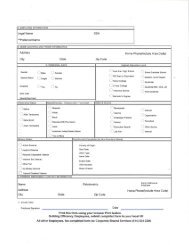
![[PDF] Download our Full Range of Li-Ion Technologies Spec Sheet](https://img.yumpu.com/23687660/1/190x245/pdf-download-our-full-range-of-li-ion-technologies-spec-sheet.jpg?quality=85)
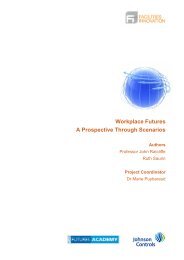
![[PDF] NA Direct & Indirect Supplier Communication Letter - Johnson ...](https://img.yumpu.com/23687657/1/190x245/pdf-na-direct-indirect-supplier-communication-letter-johnson-.jpg?quality=85)
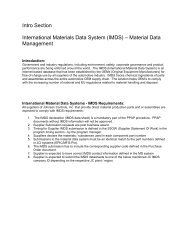
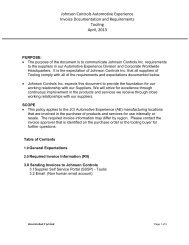

![[PDF] [PDF] - Johnson Controls Inc.](https://img.yumpu.com/23687654/1/190x245/pdf-pdf-johnson-controls-inc.jpg?quality=85)
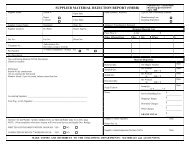
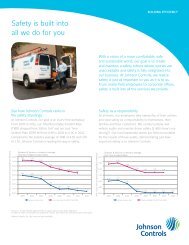
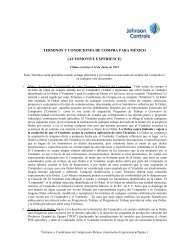


![[PDF] Warren S. Johnson Society of Retirees, Inc.](https://img.yumpu.com/23687624/1/190x245/pdf-warren-s-johnson-society-of-retirees-inc.jpg?quality=85)